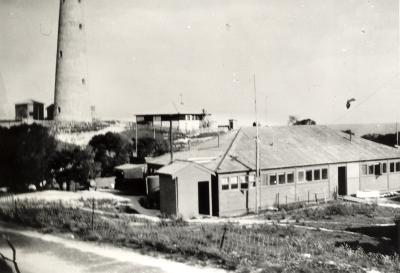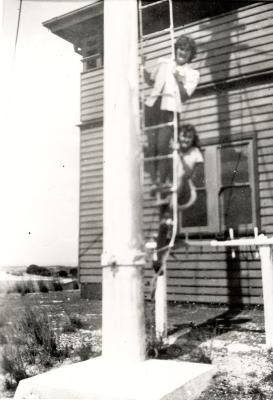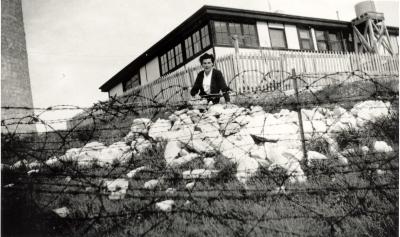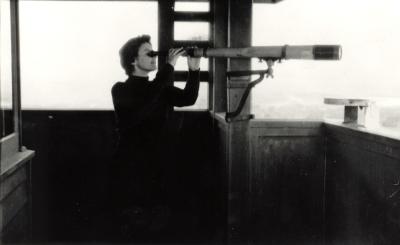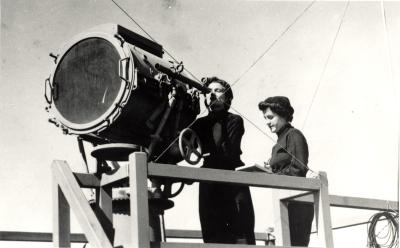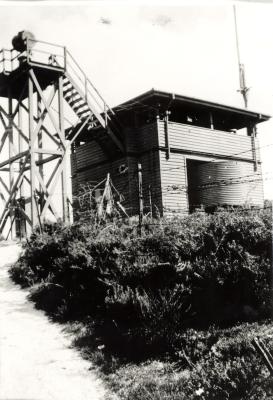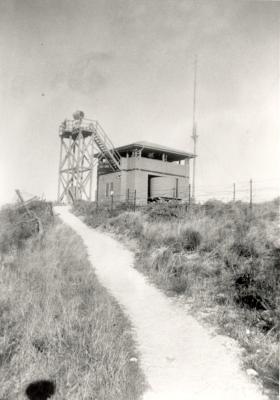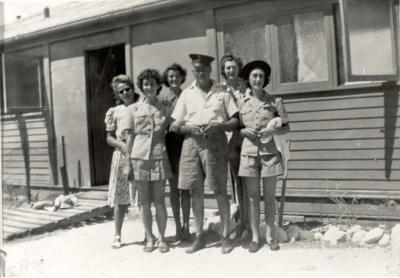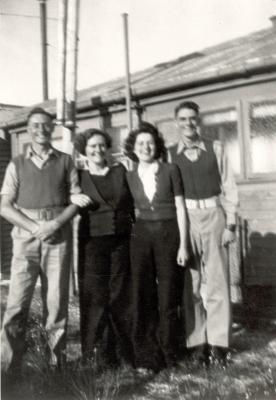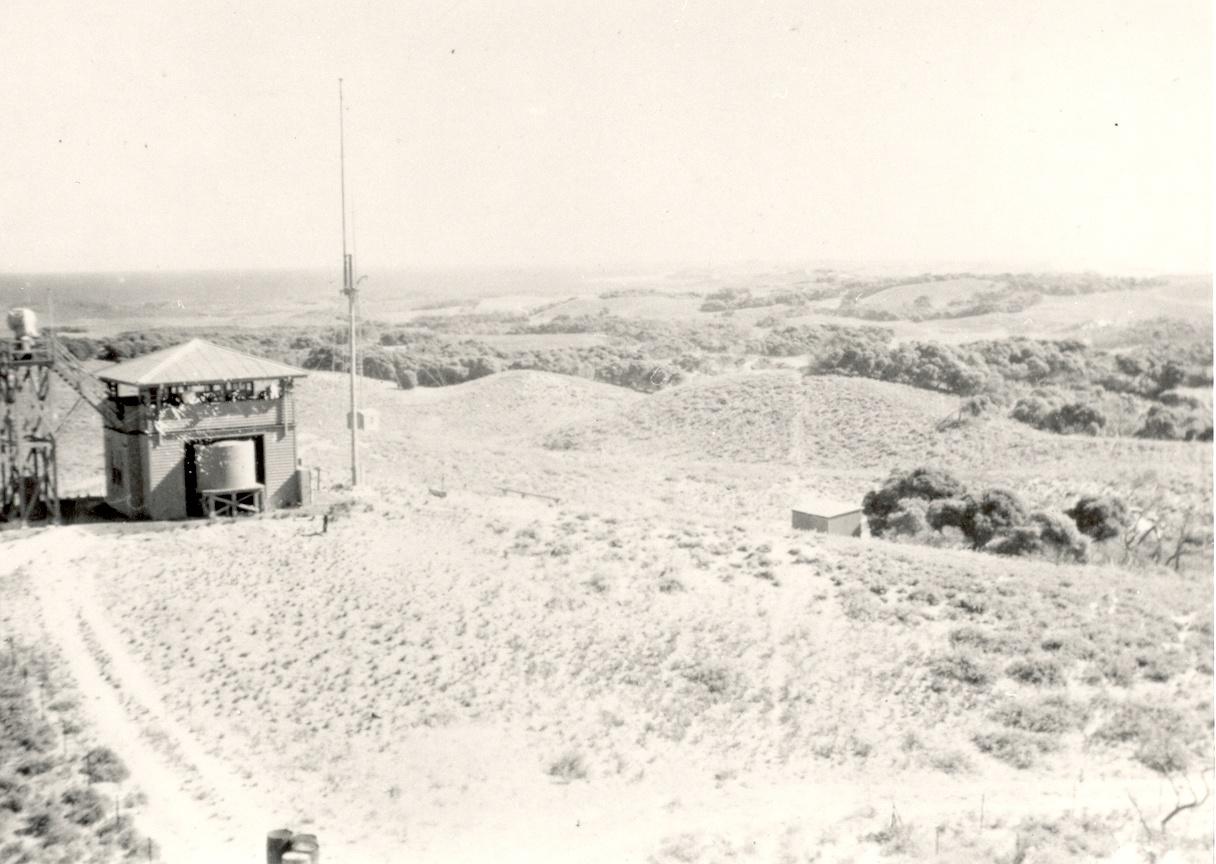Western Australia, Rottnest Island, Signal Ridge / Wadjemup. Naval Signal Station.
View of Signal Station taken from lighthouse
September 1937 saw Rottnest Island declared a permanent station for Australian troops, with personnel from the Army, Navy, Airforce, and the Australian Women’s Army Service (AWAS) and Women’s Royal Australian Navy Service (WRANS). To perform their vital defence duties, a number of other buildings were constructed to support Bickley Battery and Oliver Hill Battery.
As well as construction of a barracks at Kingstown, in 1938 a four-storey Battery Observation Post was constructed at Signal Ridge, and another at Bickley Battery. The upper floor housed instruments to observe and direct gunfire from the Oliver Hill Battery. The floors below were used by Fire Command, or Fortress Command, as it was known, a station that coordinated gunfire of all the batteries in the Fremantle Fortress area. They shared the space with important roles such as the searchlight control engineer, a signal group, and other personnel.
Wadjemup / Signal Ridge, the highest point on the Island was chosen as the site of strategic signalling and military installations. A Signal Station was originally sited at Bathurst Point in 1904, but was subsequently dismantled and moved to this more practical location. A new signal station with modern communications, signal lamps and a signal flagstaff formed part of the defence upgrade in the late 1930s. The new site allowed the signallers to see ships approaching in any direction, allowing better communication with incoming ships, and ensuring faster response times should the guns be required. Staffed by WRANS personnel, the two-storey building afforded a full 360-degree view over the island. An accommodation building and other support structures formed part of this establishment.
The Women's Royal Australian Naval service formed in April 1941 as a result of a shortage of telegraphists in the RAN. At the end of World War 2, it was disbanded, but manpower shortages in the RAN led to the service being re-constituted in 1951; it was made a permanent part of the RAN in December 1959. WRANS personnel were gradually absorbed into the RAN during the early 1980s and in due course the service was disbanded. Women were not permitted to serve aboard ships until 1983
Details
Details
Open in Google Maps
Nearest geotagged records:
- Western Australia, Rottnest Island, Signal Ridge / Wadjemup. Naval Signal Station. (0.09km away)
- Western Australia, Rottnest Island, Signal Ridge / Wadjemup. Naval Signal Station. (0.09km away)
- Western Australia, Rottnest Island, Signal Ridge / Wadjemup. Naval Signal Station. (0.11km away)
- Western Australia, Rottnest Island, Signal Ridge / Wadjemup. Naval Signal Station. (0.11km away)
- Western Australia, Rottnest Island, Signal Ridge / Wadjemup. Naval Signal Station. (0.11km away)
- Western Australia, Rottnest Island, Signal Ridge / Wadjemup. Naval Signal Station. (0.11km away)
- PHOTOGRAPH (DIGITAL): ROTTNEST ISLAND, JANUARY 1922, FROM MINNA LIPFERT ALBUM (0.12km away)
- Western Australia, Rottnest Island, Signal Ridge / Wadjemup. Naval Signal Station. (0.12km away)
- Western Australia, Rottnest Island, Signal Ridge / Wadjemup. Naval Signal Station. (0.13km away)
- Western Australia, Rottnest Island, Signal Ridge / Wadjemup. Naval Signal Station. (0.14km away)
Nearby places: View all geotagged records »
Australian Army Museum of Western Australia
Australian Army Museum of Western Australia
More items like this
Other items from Australian Army Museum of Western Australia
- Western Australia, Rottnest Island, Signal Ridge / Wadjemup. Naval Signal Station.
- Western Australia, Rottnest Island, Signal Ridge / Wadjemup. Naval Signal Station.
- Western Australia, Rottnest Island, Signal Ridge / Wadjemup. Naval Signal Station.
- Western Australia, Rottnest Island, Signal Ridge / Wadjemup. Naval Signal Station.
- World War 2, Western Australia, Rottnest Island, Signal Ridge / Wadjemup. Naval Signal Station, CREW and SKIPPINGS,1943
- Western Australia, Rottnest Island, Signal Ridge / Wadjemup. Naval Signal Station.
- Western Australia, Rottnest Island, Signal Ridge / Wadjemup. Naval Signal Station.
- Western Australia, Rottnest Island, Signal Ridge / Wadjemup. Naval Signal Station.
- Western Australia, Rottnest Island, Signal Ridge / Wadjemup. Naval Signal Station.
- Western Australia, Rottnest Island, Signal Ridge / Wadjemup. Naval Signal Station.
- Western Australia, Rottnest Island, Signal Ridge / Wadjemup. Naval Signal Station.
- Western Australia, Rottnest Island, Signal Ridge / Wadjemup. Naval Signal Station.


